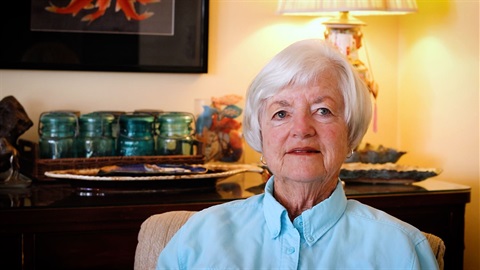OV fought to become, then to stay, a town
Published on February 07, 2024

By Dave Perry
In 1968, Tucson Mayor “Gentleman” Jim Corbett – not the famous boxer – told a TV station he intended to annex every parcel of inhabited land in the valley, “mountain to mountain,” longtime resident Twink Monrad recalls.
Residents would become Tucsonans “kicking, stomping and screaming, if necessary,” said Corbett. He vowed to reach north of the Rillito River, and along the Santa Catalina Mountains.
Corbett’s pronouncements, and subsequent county zoning proposals, didn’t sit well with Jim Kriegh, a University of Arizona civil engineering professor raising his family with wife Marjorie along Calle Concordia.
“It made him mad, and he never sounded mad,” said Monrad, a neighbor of the Krieghs with her husband Larry. “He didn’t want to be part of Tucson.”
“They wanted this area bad,” said Lauren Rhude. He served on the first elected Oro Valley Town Council, and today, at age 94, resides with Lila, his wife of 71 years, at The Watermark at Oro Valley. “Not being run by the downtown Tucson council was important to the people. There were big fights, I tell you.”
Were there ever.
With the looming threat of Tucson annexation, Kriegh, Rhude, E.S. “Steve” Engle and others quietly rallied neighbors in the shadow of Pusch Ridge. They wanted to control the community’s future. They wanted to form their own town.
Kriegh was especially “interested in a good police department,” said Monrad, who hunted rocks with Kriegh after Oro Valley’s dust had settled.
“His other important thing was the ‘no property tax’ promise,” she said. To appease incorporation opponents, proponents “promised there would never be a property tax” in Oro Valley, historian Jim Williams told guests at an Oro Valley Historical Society gathering in January. To this day, that promise is unbroken.
In a matter of days, sufficient signatures were gathered, calling for incorporation of 2.5-square-mile Oro Valley. On March 16, 1970, Kriegh and Engle presented petitions to a surprised Board of Pima County Supervisors.
“They turned them in Monday morning, and it hit the papers the next day,” Williams said. The Arizona Daily Star, and Tucson Citizen, which soon dubbed Oro Valley “Tiny Town,” called incorporation “a silly idea.”
A month later, county supervisors rejected the petitions. A complex, four-year legal fight ensued. With discounted help from attorneys, among them the still-practicing Sid Felker, Oro Valley eventually prevailed in the Arizona Supreme Court on Jan. 28, 1974. County supervisors acquiesced on April 15, 1974. The first town council was appointed on April 17.
Yet the struggle didn’t end. It moved within.
“Only half the people in the town were on their side,” said Williams, author of “Oro Valley, The First Fifty Years.” “They had two battles, Tucson and Pima County, and their own people. They were equally as difficult.”
Efforts to disincorporate began almost immediately. The town’s first mayor, Kenneth Holford, called the Oro Valley experiment “a miserable failure.”
“It was not a happy time,” Williams said. Oro Valley was broke, and angry residents feared higher taxes. In his research, Williams found record of a lengthy town council argument over the disposition of $8 in postage stamps.
Twice, in those early years, the 5-member town council considered disincorporating Oro Valley. Twice, Lauren Rhude, elected to a council seat by the narrowest of margins, cast the deciding vote that kept Oro Valley intact.
“We broke a tie, or it would have been ‘no town’,” said Rhude, matter-of-factly. For this hardened veteran of the Korean War, casting the deciding vote “didn’t bother me much.”
It all bothered Lila, Oro Valley’s volunteer town clerk. She “was very worried fisticuffs were going to happen,” Lauren said.
“You never know when people get really upset, what’s on their minds,” Lila said. “It was exciting, but it was scary, too.”
After those contentious votes, the fighting faded. “Any time you take on a new project of that type, you’re not going to have complete consensus right away,” Rhude said. “But we finally did.”
Many people pitched in to help Oro Valley succeed. Kriegh served as Oro Valley’s volunteer town engineer. “He would get called by people when it rained,” Monrad said. “They’d say ‘we couldn’t get to Oracle Road.’” Kriegh would respond late at night, giving shovels to the sons of Oro Valley’s pioneers. “They’d do what bulldozers do now.”
Jim Kriegh dug in, too. He was thorough and patient, Monrad said, “a very practical, civil engineer type.”
Above all, “Jim was the most gentle, polite, thoughtful man we’ve ever met,” said Monrad. “I never saw him lose his temper.”
Engle was “quite a guy, a typical salesman,” Rhude said of the transplanted Chicagoan. Engle, a resident of the Oro Valley Country Club Estates, would serve 12 years as Oro Valley mayor. “He was a conservative, cigar-chewing, cigar-smoking,” Rhude said. While persuasive and determined, Engle remained “steady, nice, comfortable to be around.” Kriegh was “much softer going. He was an easy-going type of guy, and smart.”
Twice a day, Twink Monrad walks in James D. Kriegh Park. Jim and Marjorie, the town’s first historian, were “very proud” of Oro Valley, Monrad said. “Being Jim,” he took little credit for Oro Valley’s birth. “He was so grateful for the attorneys, the people at the Oro Valley Country Club, everyone that helped get through the court system,” she said.
Rhude served one four-year term on the town council. “It was time to let someone else take it on,” he said. “You get the foundation right, the building goes right up. If you don’t get the foundation right, you’ve got trouble.”